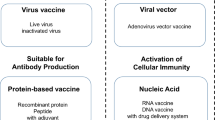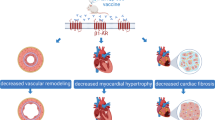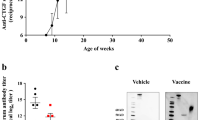Abstract
Therapeutic vaccination pre-dated modern drugs as a possible strategy for treating hypertension. This approach is now being rediscovered, through use of modified angiotensins as immunogens together with carriers and adjuvants. Effective blockade of the renin–angiotensin system (RAS) with treatment twice a year might suit patients who dislike taking drugs on a daily basis and would also be an attractive option for those who have blood pressures in the prehypertensive range, if it can prevent hypertension itself from developing. Proof of concept with a vaccine whose efficacy is easy to measure will encourage development of further vaccines directed against targets such as aldosterone or other pathways where alternative treatments are scarce or absent. Two angiotensin-based vaccines are currently in development: PMD3117 comprises modified angiotensin I coupled to keyhole limpet hemocyanin, and Cyt006–AngQb is a conjugate of angiotensin II linked to virus particles. Early phase II studies in patients with hypertension demonstrated some efficacy, but the vaccines are not as effective as existing inhibitors of the RAS. Large studies now in progress will establish whether further modification of the immunogen or adjuvant is required to boost antibody titers.
Key Points
-
The renin–angiotensin system offers a number of targets for immunization, of which angiotensins I or II seem to be the most promising
-
Swapping life-long daily drug therapy for occasional injections could be undermined because most patients require a drug to eliminate excess sodium in addition to renin–angiotensin system blockers
-
Vaccines currently in development are less effective than oral inhibitors of the renin–angiotensin system, but might provide a model for vaccination against other targets that have few alternative therapies
-
For many patients, current treatment of hypertension starts too late to reverse long-term risks of complications completely
-
Vaccination might be more attractive for prevention than treatment of hypertension
This is a preview of subscription content, access via your institution
Access options
Subscribe to this journal
Receive 12 print issues and online access
$209.00 per year
only $17.42 per issue
Buy this article
- Purchase on Springer Link
- Instant access to full article PDF
Prices may be subject to local taxes which are calculated during checkout






Similar content being viewed by others
References
Turnbull, F. Effects of different blood-pressure-lowering regimens on major cardiovascular events: results of prospectively-designed overviews of randomised trials. Lancet 362, 1527–1535 (2003).
Turnbull, F. et al. Blood pressure-dependent and independent effects of agents that inhibit the renin–angiotensin system. J. Hypertens. 25, 951–958 (2007).
Lewington, S., Clarke, R., Qizilbash, N., Peto, R. & Collins, R. Age-specific relevance of usual blood pressure to vascular mortality: a meta-analysis of individual data for one million adults in 61 prospective studies. Lancet 360, 1903–1913 (2002).
Kearney, P. M. et al. Global burden of hypertension: analysis of worldwide data. Lancet 365, 217–223 (2005).
Lopez, A. D., Mathers, C. D., Ezzati, M., Jamison, D. T. & Murray, C. J. Global and regional burden of disease and risk factors, 2001: systematic analysis of population health data. Lancet 367, 1747–1757 (2006).
Messerli, F. H., Williams, B. & Ritz, E. Essential hypertension. Lancet 370, 591–603 (2007).
Falaschetti, E., Chaudhury, M., Mindell, J. & Poulter, N. Continued improvement in hypertension management in England: results from the Health Survey for England 2006. Hypertension 53, 480–486 (2009).
Rutherford, J. C., Taylor, W. L., Stowasser, M. & Gordon, R. D. Success of surgery for primary aldosteronism judged by residual autonomous aldosterone production. World J. Surg. 22, 1243–1245 (1998).
Mancia, G. & Grassi, G. Systolic and diastolic blood pressure control in antihypertensive drug trials. J. Hypertens. 20, 1461–1464 (2002).
Chapman, N. et al. Effect of spironolactone on blood pressure in subjects with resistant hypertension. Hypertension (2007).
Perreault, S. et al. Persistence with treatment in newly treated middle-aged patients with essential hypertension. Ann. Pharmacother. 39, 1401–1408 (2005).
Brown, M. J. Renin: friend or foe? Heart 93, 1026–1033 (2007).
Brown, M. J. et al. Better blood pressure control: how to combine drugs. J. Human Hypertens. 17, 81–86 (2003).
Baigent, C. et al. Efficacy and safety of cholesterol-lowering treatment: prospective meta-analysis of data from 90, 056 participants in 14 randomised trials of statins. Lancet 366, 1267–1278 (2005).
Turnbull, F. et al. Effects of different blood pressure-lowering regimens on major cardiovascular events in individuals with and without diabetes mellitus: results of prospectively designed overviews of randomized trials. Arch. Intern. Med. 165, 1410–1419 (2005).
Hansson, L. & Zanchetti, A. Effects of intensive blood-pressure lowering and low-dose aspirin in patients with hypertension: principal results of the Hypertension Optimal Treatment (HOT) randomised trial. Lancet 351, 1755–1762 (1998).
Staessen, J. A., Wang, J.-G. & Thijs, L. Cardiovascular prevention and blood pressure reduction: a quantitative overview updated until 1 March 2003. J. Hypertens. 21, 1055–1076 (2003).
Yusuf, S. et al. Telmisartan, ramipril, or both in patients at high risk for vascular events. N. Engl. J. Med. 358, 1547–1559 (2008)
Julius, S. et al. Outcomes in hypertensive patients at high cardiovascular risk treated with regimens based on valsartan or amlodipine: the VALUE randomised trial. Lancet 363, 2022–2031 (2004).
[No authors listed]. Major outcomes in high-risk hypertensive patients randomized to angiotensin-converting enzyme inhibitor or calcium channel blocker vs diuretic: the Antihypertensive and Lipid-Lowering Treatment to Prevent Heart Attack Trial (ALLHAT). JAMA 288, 2981–2997 (2002).
Yusuf, S. et al. Effects of the angiotensin-receptor blocker telmisartan on cardiovascular events in high-risk patients intolerant to angiotensin-converting enzyme inhibitors: a randomised controlled trial. Lancet 372, 1174–1183 (2008).
Dahlof, B. et al. The Losartan Intervention For. Endpoint Reduction in Hypertension Study. Lancet 359, 995–1003 (2002).
Dahlof, B. et al. Prevention of cardiovascular events with an antihypertensive regimen of amlodipine adding perindopril as required versus atenolol adding bendroflumethiazide as required, in the Anglo-Scandinavian Cardiac Outcomes Trial-Blood Pressure Lowering Arm (ASCOT-BPLA): a multicentre randomised controlled trial. Lancet 366, 895–906 (2005).
ALLHAT Collaborative Research Group. Major cardiovascular events in hypertensive patients randomized to doxazosin vs chlorthalidone: the antihypertensive and lipid-lowering treatment to prevent heart attack trial (ALLHAT). JAMA 283, 1967–1975 (2000).
Jamerson, K. et al. Benazepril plus amlodipine or hydrochlorothiazide for hypertension in high-risk patients. N. Engl. J. Med. 359, 2417–2428 (2008).
A Systolic Blood Pressure Intervention Trial (SPRINT) Clinical Center Networks, [online]. (2008).
Harrap, S. B., Van der Merwe, W. M., Griffin, S. A., Macpherson, F. & Lever, A. F. Brief angiotensin converting enzyme inhibitor treatment in young spontaneously hypertensive rats reduces blood pressure long-term. Hypertension 16, 603–614 (1990).
Wu, J. N. & Berecek, K. H. Prevention of genetic hypertension by early treatment of spontaneously hypertensive rats with the angiotensin converting enzyme inhibitor captopril. Hypertension 22, 139–146 (1993).
Labat, C. et al. Effects of valsartan on mechanical properties of the carotid artery in spontaneously hypertensive rats under high-salt diet. Hypertension 38, 439–443 (2001).
Frohlich, E. D. The salt conundrum: a hypothesis. Hypertension 50, 161–166 (2007).
Brown, M. J. Aliskiren. Circulation 118, 773–784 (2008).
Juillerat, L. et al. Determinants of angiotensin II generation during converting enzyme inhibition. Hypertension 16, 564–572 (1990).
Belz, G. G., Butzer, R., Kober, S., Mang, C. & Mutschler, E. Time course and extent of angiotensin II antagonism after irbesartan, losartan, and valsartan in humans assessed by angiotensin II dose response and radioligand receptor assay[ast]. Clin. Pharmacol. Ther. 66, 367–373 (1999).
Mazzolai, L. et al. Angiotensin II receptor blockade in normotensive subjects: a direct comparison of three AT1 receptor antagonists. Hypertension 33, 850–855 (1999).
Calhoun, D. A., Nishizaka, M. K., Zaman, M. A., Thakkar, R. B. & Weissmann, P. Hyperaldosteronism among black and white subjects with resistant hypertension. Hypertension 40, 892–896 (2002).
Goldblatt, H., Haas, E. & Lamfrom, H. Antirenin in man and animals. Tr. Ass. Am. Phys. 64, 122–127 (1951).
Michel, J. B. et al. Immunologic approaches to blockade of the renin-angiotensin system: a review. Am. Heart J. 117, 756–767 (1989).
Michel, J. B. et al. Physiological and immunopathological consequences of active immunization of spontaneously hypertensive and normotensive rats against murine renin. Circulation 81, 1899–1910 (1990).
Michel, J. B. Renin-angiotensin vaccine: old story, new project 'efficacy versus safety'. Clin. Sci. 107, 145–147 (2004).
Michel, J. B. et al. Active immunization against renin in normotensive marmoset. Proc. Natl Acad. Sci. USA 84, 4346–4350 (1987).
Gardes, J., Bouhnik, J., Clauser, E., Corvol, P. & Menard, J. Role of angiotensinogen in blood pressure homeostasis. Hypertension 4, 185–189 (1982).
Conroy, J. M. et al. Pulmonary angiotensin-converting enzyme. Interspecies homology and inhibition by heterologous antibody in vivo. J. Biol. Chem. 251, 4828–4832 (1976).
Thurston, H. & Swales, J. D. Comparison of angiotensin II antagonist and antiserum infusion with nephrectomy in the rat with two-kidney Goldblatt hypertension. Circ. Res. 35, 325–329 (1974).
Oster, P., Bauknecht, H. & Hackenthal, E. Active and passive immunization against angiotensin II in the rat and rabbit. Evidence for a normal regulation of the renin-angiotensin system. Circ. Res. 37, 607–614 (1975).
Brunner, H. R., Kirshman, J. D., Sealey, J. E. & Laragh, J. H. Hypertension of renal origin: evidence for two different mechanisms. Science 174, 1344–1346 (1971).
Christlieb, A. R., Biber, T. U. & Hickler, R. B. Studies on the role of angiotensin in experimental renovascular hypertension: an immunologic approach. J. Clin. Invest. 48, 1506–1518 (1969).
Gardiner, S. M. et al. Active immunization with angiotensin I peptide analogue vaccines selectively reduces the pressor effects of exogenous angiotensin I in conscious rats. Br. J. Pharmacol. 129, 1178–1182 (2000).
Downham, M. R. et al. Evaluation of two carrier protein-angiotensin I conjugate vaccines to assess their future potential to control high blood pressure (hypertension) in man. Br. J. Clin. Pharmacol. 56, 505–512 (2003).
Brown, M. J. et al. Randomized double-blind placebo-controlled study of an angiotensin immunotherapeutic vaccine (PMD3117) in hypertensive subjects. Clin. Sci. 107, 167–173 (2004).
Lechner, F. et al. Virus-like particles as a modular system for novel vaccines. Intervirology 45, 212–217 (2002).
Kundig, T. M. et al. Der p 1 peptide on virus-like particles is safe and highly immunogenic in healthy adults. J. Allergy Clin. Immunol. 117, 1470–1476 (2006).
Jennings, G. T. & Bachmann, M. F. The coming of age of virus-like particle vaccines. Biol. Chem. 389, 521–536 (2008).
Ambuhl, P. M. et al. A vaccine for hypertension based on virus-like particles: preclinical efficacy and phase I safety and immunogenicity. J. Hypertens. 25, 63–72 (2007).
Tissot, A. C. et al. Effect of immunisation against angiotensin II with CYT006–AngQb on ambulatory blood pressure: a double-blind, randomised, placebo-controlled phase IIa study. Lancet 371, 821–827 (2008).
Biotechnology reports biochemical findings from phase IIa study with hypertension vaccine Cyt006–AngQb Medical News Today [online], (2009).
Author information
Authors and Affiliations
Corresponding author
Ethics declarations
Competing interests
The author is a consultant for GlaxoSmithKline Bio.
Rights and permissions
About this article
Cite this article
Brown, M. Success and failure of vaccines against renin–angiotensin system components. Nat Rev Cardiol 6, 639–647 (2009). https://doi.org/10.1038/nrcardio.2009.156
Published:
Issue Date:
DOI: https://doi.org/10.1038/nrcardio.2009.156
This article is cited by
-
Clinical study on angiotensin II vaccination—the first big step
Hypertension Research (2022)
-
Vaccines against components of the renin–angiotensin system
Heart Failure Reviews (2021)
-
New Molecules for Treating Resistant Hypertension: a Clinical Perspective
Current Hypertension Reports (2019)
-
Vaccines Against Drug Abuse
Clinical Pharmacology & Therapeutics (2012)



